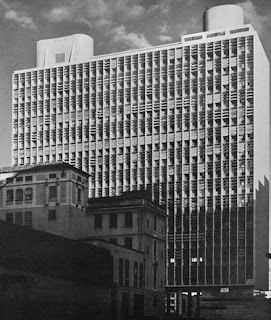Lúcio Costa, Oscar Niemeyer and others,
MES building, Rio de Janeiro, 1936–43.
MES building, Rio de Janeiro, 1936–43.
Ever since its discovery by the Portuguese in 1500, Brazil has been a mythic as well as a real place. Its empty centre in particular has been an imaginative space as much as a real one, filled with all manner of fantasies. For Brazilians themselves in the 1950s, it was the site of the construction of a new capital – a central episode in this book – an act that realized a long-held desire to unify the nation and open up commercial development of the country’s supposed vast mineral wealth.
For the foreign visitor, Brazil was for centuries an emptiness that was known to exist, but about which almost nothing could be verified. It could be imaginatively filled with the fears and desires repressed from bourgeois European civilization: sexual licence, nudity, violence, lawlessness, tropical disease, shamanist magic and dangerous animals. Arthur Conan Doyle provided the popular blueprint for this imagination of Brazil in The Lost World (1912), which describes an expedition to a plateau so remote from evolutionary processes that it is still populated by dinosaurs. Something of this exoticism persists when it comes to architecture. Brazil always seems to represent the exotic or the erotic; things are invariably possible there that are not elsewhere; the normal rules and conventions are suspended, at least discursively; it is the perennial exception. However, for the middle part of the twentieth century (usually1930–60, for reasons that will become clear), Brazil was an exemplar of modern development. During this period, it would be no exaggeration to say that Brazil was the most modern country in the world. That is not to say the most developed (it was not) or the most socially advanced (it was in most respects little changed from the colonial period), but that it was the country that had bought into the idea of modernity most comprehensively, and it wished to remake itself in that image.
The place of architecture in this scheme was crucial. For many outside the country, Brazil represented the pinnacle of what could be achieved with modern architecture given enthusiasm and the absence of the restraints of the Old World. When the Austrian poet Stefan Zweig arrived there in 1941, he dashed off a memoir of his stay called The Land of the Future. It was Introduction written, probably, as part of a bargain with the regime of President Vargas to let him stay, and is a eulogy from start to finish: everything about the place is energetic, exotic, exciting – but not enough to restore the poet’s mental equilibrium, it should be said. He and his wife committed suicide in Petropolis in 1942, apparently in despair at the state of the Europe they had left behind.
Zweig may have been under pressure from the Vargas regime to say good things, but equally, by 1942, there was plenty to say. As Zweig found, much about the country was self-consciously modern. It had an unusually well-developed air transport network. Foreign visitors increasingly flew around it by aeroplane rather than travel by land or water. It had a wealth of new infrastructural projects. It had (as we would call it now) a booming leisure industry centred on the developing resort-cityof Copacabana, the equal in sophistication to anything found in Europe.
And it had, above all, a remarkably modern architectural culture that had appeared out of nowhere, and was now doing things with concrete and plate glass that were as advanced as anything anywhere. One of the principal motivations for representatives of the Museum of Modern Art in New York to visit Brazil the year after Zweig’s book was published was to see for themselves the new technology of the brisesoleil of which they had heard in respect of the new building of the Ministry of Education and Health (Ministério de Educação e Saúde, or mes) in Rio de Janeiro. As moma’s Philip Goodwin made clear in the catalogue Brazil Builds, the treatment of the façade on modern buildings such as the mes and its near neighbour, the Associação Brasileira da Imprensa (abi), was unusual, and far in advance of anything they had encountered in the United States. They went to observe and learn.
Similarly, when the anthropologist Claude Lévi-Strauss visited Brazil for the first time in 1936, he found in São Paulo a city as self-consciously modern as any in the world. Indeed, up until the inauguration of Brasília in April 1960, Brazil was understood as a country that, whatever its limitations, was modernizing fast, and could leapfrog development in more advanced nations.











Comments
0 Response to 'Modern Brazil Architecture'
Post a Comment